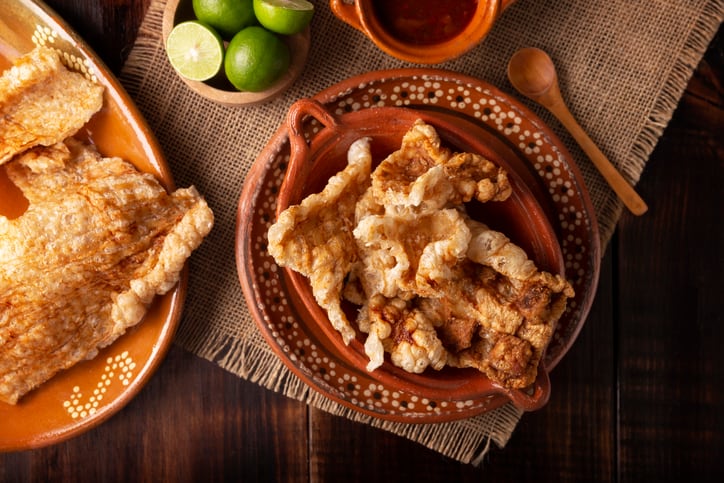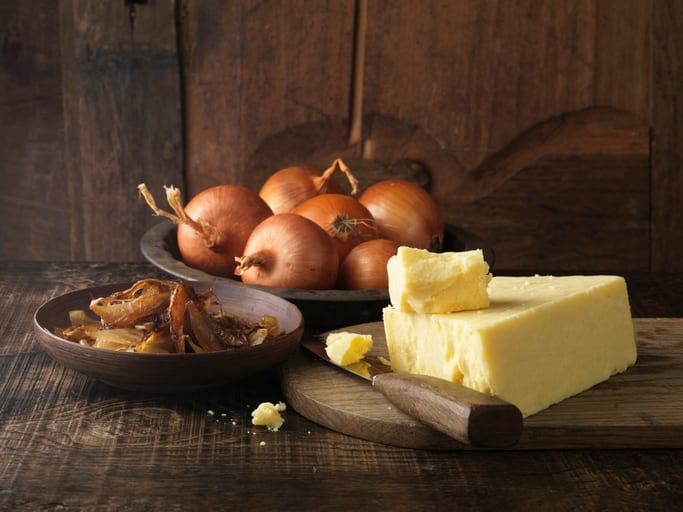Pork rinds or chicharrónes are shaking off their bad reputation as an unhealthy, lowbrow junk food and expanding beyond their Southern, blue collar and male-dominated roots to appeal to men and women nationwide, including fitness and beauty enthusiasts.
Leading this charge is Rudolph Foods, the nation’s largest pork rinds producer which recently marked its 70th anniversary – a significant milestone in the competitive CPG food and beverage industry, where 80% of businesses fail within two years.
In this episode of FoodNavigator-USA’s Soup-To-Nuts Podcast, Rudolph Foods VP of Sales and Marketing Mark Singleton recalls how the family-owned company came dangerously close to becoming part of that statistic in 1957, just two years after its founding. He recounts how the original founders quickly pivoted to survive and how the company continues to innovate its products, packaging and positioning to remain relevant, expand its consumer base and broaden chicharrónes’ usage occasions. He also offers hard-learned lessons and advice to emerging entrepreneurs trying to survive in cutthroat CPG categories.
Explore past episodes of Soup-To-Nuts podcast
Never miss an episode of FoodNavigator-USA’s Soup-To-Nuts podcast - subscribe today.
5 trends driving specialty cheese sales towards $9.2 billion by 2030 – Friesland Campina, Cypress Grove and The Melting Pot unpack how they balance consumer demand for health, indulgence and value to drive sales of specialty cheese, despite its premium pricing, in a difficult economy
Investors return to CPG, but with caution and only for the right kind of growth – Pitchbook reports a modest rebound in private equity deals in Q1 of 2025, and JPalmer Collective’s Jennifer Palmer sees reasons for optimism for mission-driven brands and women-owned and -led brands. But both warn the current uncertainty is the new norm
4 trends at IFT FIRST sending food formulators back to the drawing board - Consumers want it all - nutrient-density, satiety, clean-label and fun - and ingredient innovators at IFT FIRST are helping brands meet their myriad demands with new options and boosted production
What is driving pasta’s resurgence in the US? – Despite more than a decade of demonization of carbs and grains, pasta sales in the US continue to climb as brands break free of commodity constraints and offer more nutrient-dense and premium products that deliver an elevated experience that still is affordable and fun
Beyond sober-curious: How long is the runway for non-alcoholic beverages? – While sales of non-alcoholic beverages are growing double-digits year- over-year, new research from NielsenIQ shows most NA consumers still buy alcohol – upending assumptions and forcing brands to rethink their outreach strategy
Rudolph Foods’ secret to 70 years
For seven decades Rudolph Foods has helped chicharrónes transcend stereotypes that threaten to limit the crunchy and once regional snack, but as Singleton shares the founders did not intend to become a pork rind powerhouse and the company almost suffered the same fate as 80% of packaged food and beverage brands that never survive their second birthday.
“In today’s age, how many companies make it to 70 years? It is rare,” and almost did not happen, Singleton said.
He explained that Rudolph Foods began as a Mexican snack nut company and pork rinds were added almost as an afterthought because in 1955 they were “super simple to make” as a byproduct of bacon production which involved smoking pork with the skin on the animal.
That changed two years later when a “dastardly accounting person” decided it was less expensive and more efficient to remove the skin before smoking the pork.
“That literally put us out of business overnight,” Singleton said.
Founders John and Mary Rudolph spent day and night for two weeks to figure out how to cure skins and recreate the smoky bacon flavor their customers loved – and the recipe and process they landed on is still the basis for the business today.
“We tell people all the time, we’ve been in business since 1955, but we’ve been making the worlds best tasting pork rinds since 1957” when Mary Rudolph came up with the secret recipe, Singleton said.
The example of how the company pivoted is just one of many, he added.
“You are going to have to pivot from time to time. Things are going to change. Market conditions are going to change. Costs are going to change. We are going to have swine disease scares. We are going to have this, we are going to have that again and again and again throughout our 70 year history,” he said.
‘The knowledge of the herd is greater than the knowledge of one’
The way Mary Rudolph leaned on her family to help address that initial threat to the business became a blueprint for how she and her husband would tackle other challenges or seize opportunities over the years.
John Rudolph helped others in the industry to embrace this lesson in teamwork and partnership as well as being an “instrumental” player in the foundation of the Snack Food Association.
“He knew that the knowledge of the herd is greater than the knowledge of the one, and the sharing of that knowledge over the years really helped us in those relationships, and really got us to a place where we really believe, if we don’t overcomplicate things, we are just friends making money together,” Singleton said.
“I really think that is the secret to the 70 years: the partnerships,” he added.
How can brands diversify their consumer base?
One way that Rudolph Foods has convinced “more people to eat more pork rinds in more places” is by creating or acquiring brands that appeal to different demographics – an additive strategy that avoids alienating existing consumers by preserving the recipes, packaging and price point that they love.
A prime example is the company’s Southern Recipe brand and its better-for-you extension Southern Recipe Small Batch, which Singleton explains helped take pork rinds beyond the foundational blue-collar, male consumer to include more women and health-conscious consumers.
The idea behind Southern Recipe Small Batch came from former US President George W Bush who Singleton recalled ribbed him at an event about the high sodium content in pork rinds.
Singleton recalls that the next day he told the company he wanted to half the salt “because we are about to lose a redneck with a paycheck, and I don’t want to do that.”
The company decided as long as it was reducing the sodium it also should remove all the artificial ingredients, including colors, because as Singleton noted: “No one had written me a nice letter asking for more Yellow No. 7.”
The resulting clean label version of pork rinds became Southern Recipe Small Batch, which also featured more adventurous flavor profiles and branding that appealed to college educated consumers and women.
‘You got to be good. You just can’t look good’
While looks are important in CPG and play an important role in the success of Southern Recipe Small Batch, Singleton stresses that authenticity – in flavor, shape and use – is more important than looks. As an example, he pointed to the company’s oldest brand – Pepe’s – which is designed by and for Hispanic consumers.
“Our biggest consumption per capita is, obviously, our Hispanic consumer. So many people on our team in Texas and California have come from Hispanic heritage, so we are blessed to have authentic input, authentic versions of what this consumer wants, how they use the product. You know, it is not our interpretation, it is not our focus group, it is not a study. These are our people showing us what their culture does with the product,” Singleton said.
The result is a line of products with a wide range of shapes and textures, which is growing 50% more than the category as a whole.
Under the Pepe’s brand, the company also offers a plant-based option that is just as authentic as pork-based chicharrónes.
How to know when to pull the plug on a new product that is not making the cut?
While Rudolph Foods embraces experimentation and segmentation, Singleton said it also has strict production thresholds and regular reviews for its SKUs to ensure they are holding their own and align with consumer trends.
He explained the company reviews SKU performance quarterly and he tracks some numbers daily and weekly. If a product is not meeting the mark, the company first puts it on “emergency assistance,” and if that does not work “it joins the dodo bird.”
Rationalizing SKUs is inevitable because consumer tastes and price point sensitivity change, he said.
The recent push to remove artificial dyes and ingredients from packaged foods in the US is only one example of how consumer demands have evolved in the 70 years since Rudolph Foods launched. But Singleton says a key to staying in business is to view shifting consumer priorities as an opportunity, rather than a threat.
For example, when consumers began taking note of the impact of their diet on their health, pork rinds easily could have fallen out of favor as a “junk food,” but Singleton explained the company chose instead to lean into pork rinds’ high protein and collagen, low carbs and majority proportion of “good fats” to recast chicharrónes as a diet and beauty from within food.
The power of a ‘good plan’
While Rudolph Foods has had its share of struggles in the past seven decades, Singleton reiterated much of the company’s long-term success boils down to having an open mind to try something new, a realistic execution strategy and, just as founders John and Mary discovered, strong partnerships.
“There is not anything that can be accomplished without a good plan,” he said. “And so, I tell people, you’ve got to set a realistic goal.”
This includes not only how to make a product and get it on shelf, but how to get it off shelves and be good partner to retailers that stock it.




